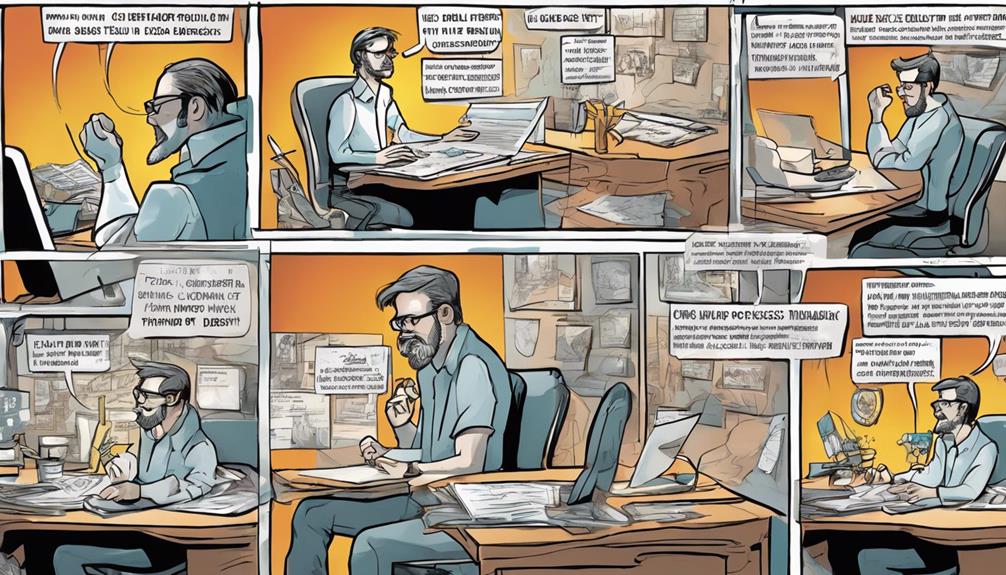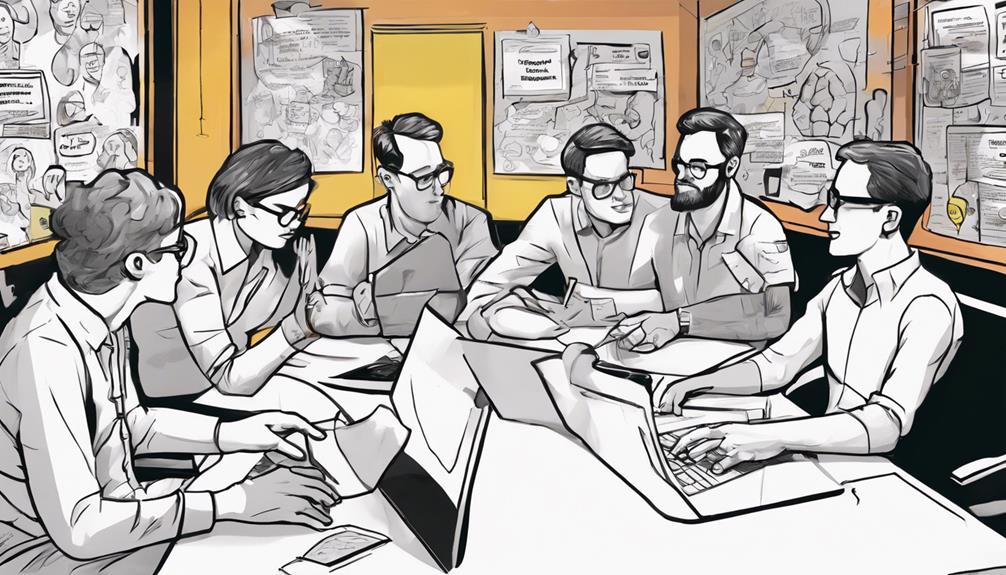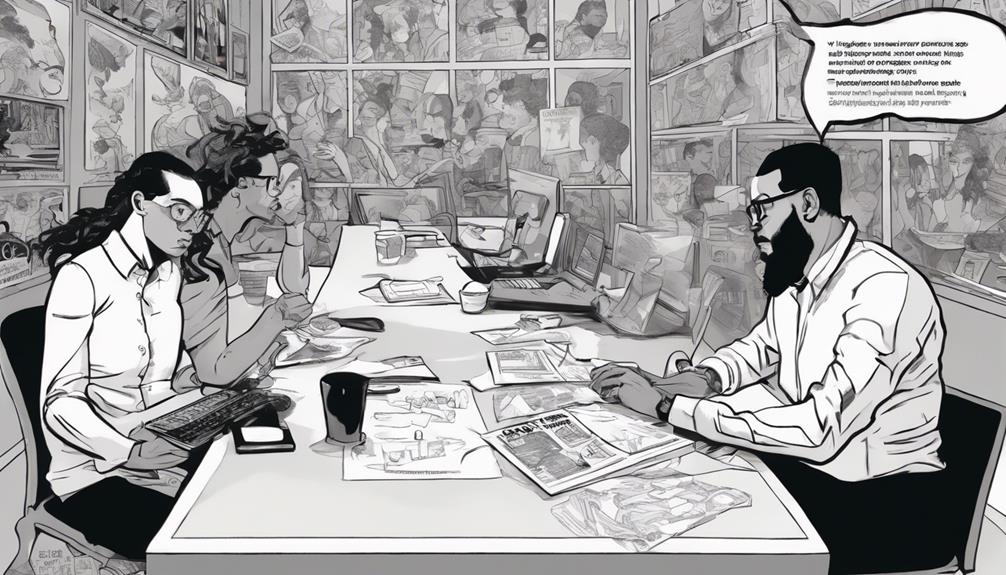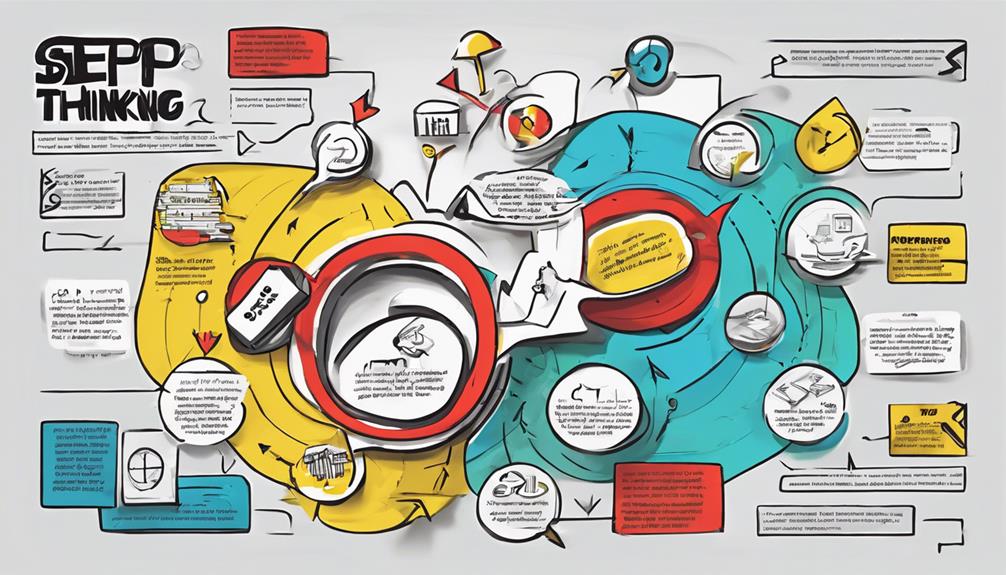When considering human-centered design thinking, one aspect that doesn't inherently provide an advantage is managerial problem-solving. While this methodology excels in user-centric product design, flexibility in creation, market problem understanding, and solution usefulness assurance, managerial problem-solving falls outside its core strengths. If you want to uncover more insights on how human-centered design thinking can benefit your projects, explore further into the diverse advantages it offers, from innovation and creativity to crafting solutions that resonate with your audience's needs and preferences.
Key Takeaways
- Neglects business objectives and profitability.
- May overlook technical feasibility constraints.
- Potential delays in product development.
- Limited focus on scalability and market competitiveness.
- Less emphasis on industry standards and regulations.
User-Centric Product Design
User-Centric Product Design prioritizes the specific needs and preferences of users to create tailored products/services. This approach, rooted in human-centered design thinking, allows users to actively participate in the design process, ensuring that the final product meets their expectations and requirements.
By focusing on the end-users from the initial stages of product development, businesses can enhance user satisfaction and usability, ultimately leading to increased customer loyalty and engagement.
Human-Centered Design Thinking promotes innovation by continuously seeking feedback and insights from users, enabling companies to address evolving market demands effectively. This user-centric approach not only fosters a deeper understanding of customer needs but also encourages creativity and ideation, driving the development of innovative solutions that resonate with the target audience.
Flexibility in Creation Process

You can expect the flexibility in the creation process to be a game-changer. It allows for a more creative problem-solving process, ensuring your designs are innovative and user-centered.
With this approach, you'll witness enhanced user experiences and iterative product development that aligns closely with user preferences.
Creative Problem-Solving Process
Embracing a flexible problem-solving process in human-centered design thinking allows for iterative improvements and user feedback-driven enhancements. By integrating user perspectives throughout the design process, you can cultivate more creative solutions that truly address user needs.
This creative problem-solving approach encourages the generation of innovative ideas and out-of-the-box solutions that may not have been considered otherwise. The flexibility in the creation process enables you to swiftly adapt to changing user needs and preferences, guaranteeing that the final product or service remains relevant and effective.
Through this user-centric design thinking process, you can foster a dynamic and adaptable approach to product or service development. This iterative cycle of gathering feedback, refining designs, and re-evaluating solutions guarantees that the end result is tailored to meet user expectations effectively.
Enhanced User Experience
Incorporating adaptability in the creation process under Human-Centered Design Thinking enhances user experience by enabling iterative improvements based on user feedback.
This methodology that focuses on the design process allows for a more dynamic approach to product or service development. By being open to making changes throughout the design process, you can secure that the final outcome meets the needs and preferences of the end-users effectively.
This flexibility also allows you to address any issues or concerns that may arise during testing phases promptly. Ultimately, by embracing adaptability in the creation process, you can create solutions that are more user-centric and tailored to provide an enjoyable and satisfying experience for your target audience.
Iterative Product Development
Flexible iterative product development within Human-Centered Design Thinking allows for continuous adaptation to changing user needs and preferences. This iterative approach involves creating, testing, and refining products/services in collaboration with users to ensure that their requirements are met effectively. By incorporating user feedback at each stage of the design process, Human-Centered Design fosters a deep understanding of user preferences, leading to more personalized and relevant offerings. This adaptability enables quick adjustments and refinements to enhance the overall user experience, ultimately resulting in higher levels of user satisfaction and loyalty.
| Pros | Cons |
|---|---|
| Enhanced user satisfaction | Time-consuming process |
| Tailored product offerings | Requires active user involvement |
| Continuous improvement | Potential for scope creep |
| Increased user loyalty | Iterations may lead to delays |
| Better understanding of user needs | Resource-intensive |
Market Problem Understanding

Understanding market issues profoundly is a core benefit of Human-Centered Design Thinking. This approach explores the intricacies of the challenges faced by the market, allowing for a thorough understanding of the root issues.
By focusing on unraveling these problems through empathetic research and analysis, Human-Centered Design Thinking ensures that the solutions developed aren't only effective but also resonate with the actual needs of the end-users.
Through this methodology, products and services are tailored to address real market demands, leading to a higher likelihood of success in the market.
Additionally, by honing in on market issues, Human-Centered Design Thinking cultivates an environment that fosters innovation and creativity in problem-solving processes. This profound understanding of market challenges is instrumental in driving strategic decision-making and developing solutions that aren't only relevant but also impactful.
Managerial Problem-Solving

Utilizing human-centered design thinking in managerial contexts enhances problem-solving by emphasizing strategic decision-making and user-centric solutions. This approach enables managers to explore deeply into market challenges and address them effectively through thoughtful strategies and user-focused solutions.
By incorporating human-centered design principles, managers can guarantee that their problem-solving methods aren't only efficient but also tailored to meet the needs of their target audience. The emphasis on managerial skills in human-centered design thinking underscores the importance of creating products and services that resonate with users.
Through this approach, managers can leverage their problem-solving abilities to develop practical and valuable solutions that cater to the specific requirements of their intended beneficiaries. By prioritizing user needs and preferences, managers can navigate complex market problems with clarity and purpose, ultimately leading to the delivery of innovative and impactful solutions.
Solution Usefulness Assurance

Incorporating human-centered design thinking in managerial problem-solving guarantees the practicality and effectiveness of solutions for the intended beneficiaries. This approach ensures that solutions aren't only innovative but also directly address the real needs of the market.
By focusing on understanding the problems faced by the target audience, human-centered design thinking leads to more user-centric and effective outcomes. It involves actively engaging with the end-users throughout the design process to validate ideas and iterate on solutions until they meet the users' requirements.
Enjoyable User Experience

Enhancing customer contentment and fostering increased user involvement, human-centered design thinking prioritizes providing pleasurable user experiences. By focusing on user needs and preferences, this approach ensures that products and services are crafted with the end user in mind, ultimately leading to amplified satisfaction.
When users have a delightful experience with a product or service, they're more likely to engage with it and remain loyal over time.
Moreover, creating pleasurable user experiences can set a product or service apart in a competitive market. The positive emotional connection that users have with a well-designed product can attract more customers and contribute to long-term success.
Human-centered design thinking highlights the significance of understanding and addressing user emotions, ultimately leading to a more satisfying and enjoyable user experience. By prioritizing user contentment and engagement, this approach can help businesses thrive and build lasting relationships with their customers.
Innovation and Creativity

Design thinking ignites creativity and innovation by focusing on user needs and experiences. By prioritizing understanding the users' viewpoints and challenges, design thinking fosters inventive solutions that directly cater to market requirements. This strategy places importance on empathy and user feedback, enabling the creation of imaginative responses to intricate problems. Through human-centered design, products and services are customized to fulfill genuine user demands, nurturing a culture of innovation within organizations.
The focus on user-centric solutions in design thinking not only guarantees that products resonate with the audience but also stimulates creativity in problem-solving processes. By consistently striving to enhance user experiences and meet their needs efficiently, design thinking challenges teams to think innovatively and generate unique, creative concepts. This user-focused approach nurtures a mindset of ongoing innovation and creativity, resulting in the formulation of solutions that genuinely impact users' lives.
Solutions Beneficial to Audience

You'll find that Human-Centered Design Thinking guarantees that the solutions crafted are tailored to meet your specific needs and desires.
By focusing on what matters to you, this approach creates products and services that address your unique requirements effectively.
Ultimately, Human-Centered Design Thinking aims to enhance your satisfaction and loyalty by delivering solutions that truly resonate with you.
Audience-Centric Solutions
Crafting solutions that cater specifically to the audience's needs and preferences is a hallmark of Human-Centered Design Thinking. This approach ensures that the end product resonates with users, leading to higher satisfaction levels and increased loyalty.
When employing Human-Centered Design Thinking, you benefit from the following audience-centric solutions:
- Tailored User Experience: By customizing products/services to align with user preferences, you create a personalized and engaging experience.
- Enhanced User Satisfaction: Addressing specific user needs directly results in higher satisfaction levels and increased trust in your brand.
- Market Demand Alignment: By integrating user feedback and interactions, you can align your offerings with market demands more effectively.
- Relevant Solutions: Understanding user behavior and needs enables you to develop solutions that aren't just innovative but also highly relevant and useful to your audience.
Incorporating these audience-centric solutions into your design process can greatly impact the success and relevance of your offerings.
User-Targeted Benefits
Focusing on the user-targeted benefits of Human-Centered Design Thinking, you guarantee that solutions directly address the specific needs and preferences of your audience. By tailoring products and services to meet the exact requirements of the end-users, you ensure that the solutions provided are not only relevant but also highly valuable. This approach leads to higher user satisfaction and loyalty as their feedback and interactions are incorporated into the design process. Through Human-Centered Design Thinking, you're more likely to develop solutions that effectively meet real market needs while enhancing the overall user experience by prioritizing user perspectives and requirements.
| User-Targeted Benefits | Description |
|---|---|
| Tailored Solutions | Solutions are customized to meet the specific needs and preferences of the target audience. |
| Higher User Satisfaction | User feedback and interactions lead to increased satisfaction and loyalty among the end-users. |
| Real Market Needs | Solutions developed through this approach are more effective in addressing genuine market needs. |
Balancing User Preferences

Achieving a balance between user preferences and technical constraints is a key challenge in human-centered design thinking. It involves aligning user needs with what's technically feasible to create successful products that meet user expectations while ensuring functionality.
To achieve this balance effectively, consider the following:
- User Needs Assessment: Conduct thorough research to understand the users' preferences, behaviors, and pain points.
- Technical Feasibility Analysis: Evaluate the technical limitations and possibilities to determine what can be realistically implemented.
- Iterative Prototyping: Create prototypes to gather user feedback early on and make necessary adjustments to align user preferences with technical constraints.
- Collaborative Decision-Making: Involve cross-functional teams to collaborate on finding solutions that balance user preferences with technical feasibility.
Frequently Asked Questions
What Is an Advantage of Human-Centered Design Thinking?
When you think about what is an advantage of human-centered design thinking, consider how it enhances user experience, allows for flexibility in creation, guarantees solutions benefit the audience, and focuses on solving problems effectively.
What Are the Advantages and Disadvantages of Design Thinking?
Explore design thinking's dynamics, uncover its advantages, and drawbacks. Embrace its user-centric essence for improved problem-solving, but be cautious of potential limitations like time constraints and overemphasis on user input that may arise.
Which of the Following Is Not Part of the Design Thinking Process?
To identify what's not part of the design thinking process, focus on understanding its stages: empathize, define, ideate, prototype, test, and implement. Each step contributes to problem-solving and innovation, ensuring a user-centered approach throughout.
What Are the Disadvantages of a Design With Human-Centered Computing Consideration?
When designing with human-centered computing in mind, you'll find the process time-consuming, balancing user preferences with technical feasibility a challenge. Understanding user behavior deeply is essential, and traditional design resistance may hinder implementation.
Conclusion
So, when it comes to human-centered design thinking, it's important to remember that not all advantages are created equal. While user-centric product design, flexibility in the creation process, and market problem understanding are all key benefits. Solution usefulness assurance, enjoyable user experience, innovation, and creativity are also important aspects. Solutions beneficial to the audience and balancing user preferences are crucial considerations.
Managerial problem-solving may not necessarily be an advantage. Did you know that companies that prioritize user experience see an average increase in revenue of 37%? That's a statistic worth considering.









